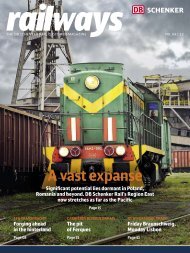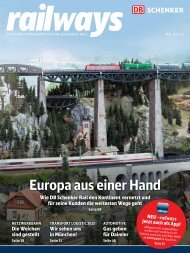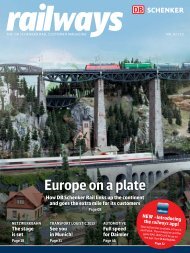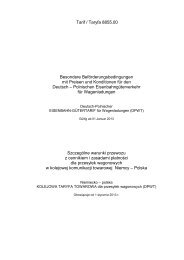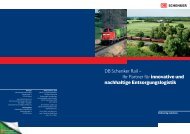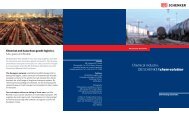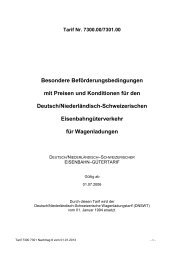Create successful ePaper yourself
Turn your PDF publications into a flip-book with our unique Google optimized e-Paper software.
Brenner 2.0, even deeper<br />
The third base tunnel<br />
under the Alps is under<br />
construction deep beneath<br />
the Brenner Pass between<br />
Innsbruck and Bolzano.<br />
The 55-kilometre long rail<br />
tunnel is set to be finished<br />
in 2025.<br />
RESEaRcH:<br />
In Aicha in South<br />
Tyrol, the construction<br />
workers are<br />
building an exploratory<br />
tunnel to<br />
investigate the<br />
geology of the<br />
mountain.<br />
20 | <strong>Rail</strong>ways<br />
Europe’s highest transport bottleneck is getting<br />
new, high-tech boltholes. Three super-modern<br />
rail racetracks will downgrade the Alps from<br />
high mountains to hills as far as the railways are concerned.<br />
In Switzerland, trains have been running<br />
through the 35-kilometre long, mainly single track<br />
Lötschberg Base Tunnel (highest point 828 metres<br />
above sea level) since 2007. A little further east, the<br />
Gotthard Base Tunnel has already broken through.<br />
At a length of 57 kilometres, the record-breaking<br />
dual track tunnel will set a new world record for railway<br />
tunnels when it opens at the end of 2016, and<br />
will cross over the Alps at a maximum altitude of just<br />
549 metres above sea level, or rather cross under them<br />
(see also railways 2/11).<br />
And now: the Brenner. The historic pass between<br />
Innsbruck and Bolzano will no longer run over the<br />
mountain in future, but will delve beneath the mountain<br />
instead. From 2025, the Brenner Base Tunnel, 55<br />
kilometres in length, and its construction now gathering<br />
pace, will relieve the bottleneck on the central EU<br />
rail axis between Berlin and Palermo, speeding up rail<br />
transport and greatly increasing capacity on the rails.<br />
Today, freight trains toil up a 145-year-old line from<br />
Innsbruck up into the Brenner Pass, at an altitude of<br />
1,371 metres above sea level, and back down on the<br />
Italian side. In future, the underground rail line will<br />
cross the Alpine ridge at an altitude of 795 metres, com-<br />
ing out again with no major gradients or tight curves.<br />
The two separate tunnels, each with one line in each<br />
direction are designed for maximum speeds of up to<br />
250 km/h, which will considerably speed up both passenger<br />
and freight transport over the Brenner Pass.<br />
The first section – the access tunnel from Mauls and<br />
the first segment of the exploratory tunnel (Aicha) –<br />
has been completed in Italy. Work is now continuing<br />
in a northerly direction. The next phase is to drill<br />
through the Periadriatic Seam, a fault zone in which<br />
work must be undertaken with great care. In Austria,<br />
the Innsbruck-Ahrental exploratory tunnel, the Ahrental<br />
access tunnel, the Wolf access tunnel, the Padaster<br />
tunnel and the Saxen tunnel are all currently<br />
being driven.<br />
In 1994, the EU added the Berlin-Naples corridor<br />
to the list of priority projects as a scheme of prime importance.<br />
Ten years later, Austria and Italy signed a<br />
state treaty to begin the construction of the Brenner<br />
Base Tunnel. The same year saw the foundation of the<br />
international project company BBT SE. It works on<br />
behalf of the Republic of Austria, the Republic of Italy<br />
and the European Union to plan and build the Brenner<br />
Base Tunnel. SE stands for Societas Europaea, an international<br />
form of company under European law. BBT<br />
SE is 100 per cent publicly owned.<br />
ok<br />
http://www.bbt-se.com/unternehmen/<br />
UnFoLD AnD Be AMAzeD: On the next few pages,<br />
railways invites you to join us on a spectacular mountain<br />
tour. Take a look at the Brenner Pass as you’ve never<br />
seen it before! Find out more about the future Brenner<br />
Base Tunnel and take a look at the historic railway line on<br />
the border of Tyrol (southern Austria) and South Tyrol<br />
(Italy)! Over the coming summer, this central European<br />
railway thoroughfare will be closed for weeks, because<br />
the Austrian section of the line from Innsbruck to the<br />
Brenner Pass is in urgent need of repair. More about this<br />
on page 25. >>>>>>><br />
Photo: BBT PR<br />
summer closure<br />
of the Brenner <strong>Rail</strong>way<br />
From 6 August to 10 September, renovations will be carried out on the northern ramp from<br />
Innsbruck to the border. There will be wide-ranging diversions to rail freight traffic.<br />
57,000 metres of rails, 46,000 sleepers and up to<br />
130,000 tonnes of ballast and building materials<br />
will be used this summer on the Austrian section<br />
of the Brenner <strong>Rail</strong>way to make the northern ramp up<br />
to the border crossing, at an altitude of 1,370 metres,<br />
fit for the next 10 to 15 years. Renewal of two tunnel<br />
vaults and drainage measures on 20 kilometres of line<br />
are also part of the plans. All this to improve the<br />
power supply and the safety of the tunnel.<br />
In order to carry out the building work on this busy<br />
mountain line as effectively as possible, the infrastructure<br />
operator of the Österreichische Bundesbahn<br />
(ÖBB) has imposed a five-week full closure of the line<br />
and two further months of one-way operation. However,<br />
these restrictions will mean considerable challenges<br />
for international rail freight traffic between<br />
Munich and Verona: the alternative routes via the<br />
Tauern <strong>Rail</strong>way (Villach-Tarvisio) to the east and via<br />
Switzerland require diversions of several hundred<br />
kilometres.<br />
The timetables for the period of one-way operation<br />
and the complete closure are available for all trains<br />
with which <strong>DB</strong> <strong>Schenker</strong> <strong>Rail</strong> has any involvement.<br />
“With around five hours added to the journey times<br />
via the diversion routes, the departure or arrival times<br />
will differ from the regular timetable. The final details<br />
are currently being worked out with customers and<br />
terminal operators,” says Manfred Forster, head of the<br />
<strong>DB</strong> <strong>Schenker</strong> <strong>Rail</strong> cargo control centre in Munich.<br />
Closure of the Brenner <strong>Rail</strong>way in detail:<br />
• Complete closure from 6 August to 10 September<br />
(no rail traffic).<br />
• Weekend complete closures from Saturday 8 am to<br />
Tuesday 5 am on six further dates from mid-June to the<br />
end of September.<br />
• Partial one-way operation<br />
from 11 June through to September.<br />
“The diversion route via Tauern will be almost 100<br />
per cent utilised from Monday to Friday, so all those<br />
involved will need to work very precisely to ensure<br />
punctual transports.”<br />
During the period of one-way operation, around 85<br />
to 90 per cent of the planned transport volume will<br />
be sent via the Brenner. There will be no replacement<br />
for the rolling highway during the complete closure,<br />
but for all other intermodal traffic alternative rail solutions<br />
can be found.<br />
The effects of the Brenner closure will be mitigated<br />
by their timing during the Bavarian, Austrian and<br />
Italian summer holidays. In this traditionally lowtraffic<br />
period, freight volume on the Brenner falls by<br />
30 to 40 per cent, according to information from ÖBB.<br />
Even without a complete closure, the almost 150year-old<br />
Brenner <strong>Rail</strong>way has proven to be a bottleneck<br />
for European rail freight transport, in the 21st<br />
century more than ever. Tight curves and gradients<br />
of up to 2.5% limit train lengths to 550 metres. To overcome<br />
the steep climbs, heavy trains are pulled by two<br />
locomotives and supported by a third bank engine.<br />
With support from the EU and after decades of preparation,<br />
construction work on the Brenner Base<br />
Tunnel started in 2010. With a length of 55 kilometres,<br />
the tunnel is set to create a rapid and flat line through<br />
the mountain massif from 2025 onwards (see page 20).<br />
ok<br />
41.9 million<br />
tonnes of freight<br />
were transported over the Brenner Pass in 2010, of which<br />
14.4 million tonnes, or 34 per cent, travelled by rail. As a<br />
comparison: the proportion of freight transported by rail<br />
over the most important Swiss Alpine pass, the St Gotthard,<br />
is 57 per cent.<br />
1,104 metres<br />
in altitude<br />
– that’s how far the southern ramp of the Brenner <strong>Rail</strong>way<br />
climbs from Bolzano up to the pass at an altitude of 1,371<br />
metres at the Austrian-Italian border post. On the northern<br />
ramp, it is a climb of 790 metres from Innsbruck up to<br />
the altitude of the pass.<br />
145th birthday<br />
to be celebrated by the Brenner <strong>Rail</strong>way on 12 August<br />
(during its complete closure). When it opened in 1867,<br />
the whole line was on Austro-Hungarian territory. The<br />
border crossing at the top of the Brenner Pass has only<br />
existed since South Tyrol became part of Italy in 1919.<br />
CoMPAnY & PeoPLe<br />
<strong>Rail</strong>ways | 25




